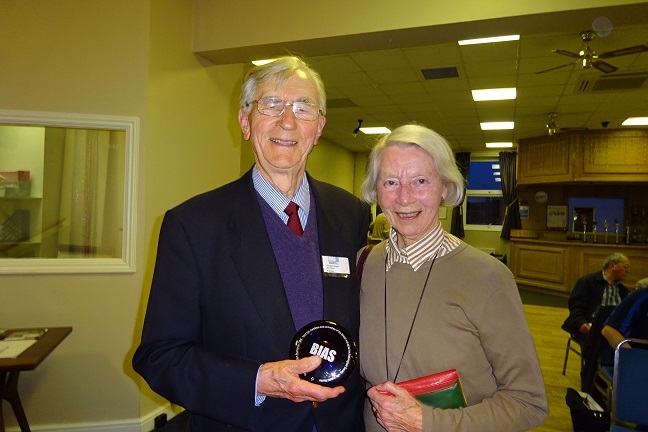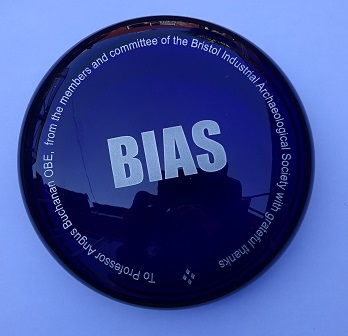BIAS Titan
BIAS members and all those with an active interest in Industrial Archaeology (IA) wherever it is pursued will be saddened to learn of the passing of Professor R. Angus Buchanan OBE at the Royal United Hospital in Bath on 17 June, last. He died peacefully following a fall at his home shortly after his 90 th birthday and some two months after the death his wife Brenda.
Angus was a much-respected scholar in the fields of the history of technology and IA and played an important part in the formation of our society and in promoting research into the industrial past of the area around Bristol and Bath. At the time of writing it is understood that obituaries are being prepared for national publication that will no doubt deal with his contribution to these disciplines in the UK and internationally. The following notes and reflections aim to focus mainly upon his role in BIAS and the local area.
Angus moved to Bristol in 1960 to take up a teaching job at what was soon to become one of the new Colleges of Advanced Technology and, in 1966, the new Bath University of Technology where he remained in post until retirement in 1995. After this, he continued to convene meetings of the Centre for the History of Technology (latterly re-named the History of Technology Research Unit) at the university until shortly before his death. He had set up the centre whilst working in Bristol where he also organised extra-mural courses at the Bristol Folk house and took part in residential conferences that were to prepare the way for the rapid growth of interest and activity in IA in the late 1960s and the early years of the next decade. The papers delivered at a course held in 1965, subsequently edited by Kenneth Hudson, have been published as The Industrial Past and Industrial Present (Bath University Press, 1967) and provide an interesting insight into the challenges to be faced at the time.
It was from the Folk House courses that Angus and Neil Cossons, then Curator of Technology at Bristol Museum, joined with other participants to form BIAS in 1967. Recollections of these early days are recorded in BIAS Journal 49, published in our 50 th anniversary year, and in the transcript of an interview with William Hanna in Bath History XIII (2013). Angus became the first BIAS chair and Neil its secretary. He also edited the journal which first appeared in 1968. The term of office for the chair was limited to two years at the time but Angus was to continue as editor until 1978 when his editorial ‘Ten Years of BIAS’ celebrated achievements and identified matters that ‘still required our attention’. These early journals are now available to all on the BIAS website and his words provide an interesting commentary on the progress of the society and the discipline. In the early 1970s Angus had already taken on responsibilities at national and international levels which included the presidency of the Association for Industrial Archaeology (AIA) and representation on committees of the Royal Commission on the Historical Monuments of England (RCHME), the National Trust and the International Committee for the History of Technology (ICOTHTEC).
He did not, however, neglect his local area and was a founder-member of the History of Bath Research Group (HBRG) and a trustee of the Bath Archaeological Trust (BAT). He remained as a member of BIAS Committee for a number of years and became our first president in 1991. As such he chaired the BIAS AGM, was a member of the judging panel for the BIAS Brunel Prize and hosted the regional conferences when organised by BIAS. He kept in touch with society business in his later years, took a keen interest in the committee minutes and was always on hand to give an opinion and offer advice when asked.
I did not get to meet Angus until I moved permanently to the area in 1984 but profited greatly during my early days in IA from reading his books and editorials – I made a habit of purchasing early journals at the museum on Queens Road whenever I visited Bristol. Of particular influence was his ”Industrial History of the Bristol Region (with Neil Cossons, 1969) and his Pelican Industrial Archaeology in Britain that was first published in 1972 when I was preparing my first modest offering on Barnstaple’s IA. Together with Arthur Raistrick’s Industrial Archaeology: An Historical Survey, also published in that year, the two books provided contrasting approaches to the development of the study since the appearance of Kenneth Hudson’s pioneering Industrial Archaeology in1963. I was later to discover and learn much from his briefer surveys of IA in Bristol (1967) and Bath (1969) and his definitive biography Brunel (2002).
Having worked with Angus as BIAS President during my second stint as its chair, it was a pleasing surprise to renew this relationship at national level when AIA decided to appoint an executive chair to manage the organisation in tandem with a distinguished President to act in a ‘ceremonial’ role. Such divisions of responsibility sometimes prove difficult but Angus, down-to- earth Yorkshireman that he was, made it clear from the outset that I was to ‘do the work’ – so I gave him the AIA’s medal of office that had survived this reorganisation and we got on with our respective jobs with never a cross word.
I have particularly fond memories of his company and conversation on such occasions as the presentation of AIA’s annual conference awards that usually took place in deep mid-winter after the autumn event. This involved long journeys on the motorways in difficult conditions and, on one occasion, of a flying visit to the Isle of Man when the island’s frequent fog almost disrupted a tight schedule of presentations and media interviews. His reminiscences of past events and opinions of some of his colleagues in IA during these excursions were quite revealing – but not to be repeated here!
Angus will be greatly missed. He played a significant part in changing the way we see and respond to the industrial past of our area and the wider world. In doing so he always demanded high standards of others but was quick to encourage the efforts of those who lacked his intellect and experience of the academic world. At the BIAS AGM in 2015, Angus Buchanan stepped down as president having been a founding member in 1968. We presented him with a blue glass paperweight to commemorate this momentous occasion and thanked him for all his hard work (see the front page of the bulletin). BIAS was formed in 1967.
At a recent BIAS AGM, Stuart Burroughs paid tribute to the memory of Joan Day and Owen Ward, two other early members, by saying that we, as their successors, were ‘standing on the shoulders of giants’, a metaphor attributed to Sir Isaac Newton and subsequently engraved on the edge of our £2 coins. If founding and developing BIAS was, as Stuart observed, the work of giants then Angus was a veritable titan. It is now up to us to build upon his legacy.
Mike Bone (past chairman)
This is very sad news. I had known Angus from the very early days of the proposals to rescue the Great Britain (when we also formed the Brunel Society) although as I recall he did not take an active part in the preliminary meetings held at the Museum, these were organised by Neil Cossons, but Angus was always in the background providing encouragement. In later years I met Bob Martin and it was he who encouraged me to join BIAS which I did after I retired in 1994. I was very grateful to Angus for his wise and encouraging comments on the draft for my Great Eastern article for the BIAS journal in 2015.
Keith Hickman


